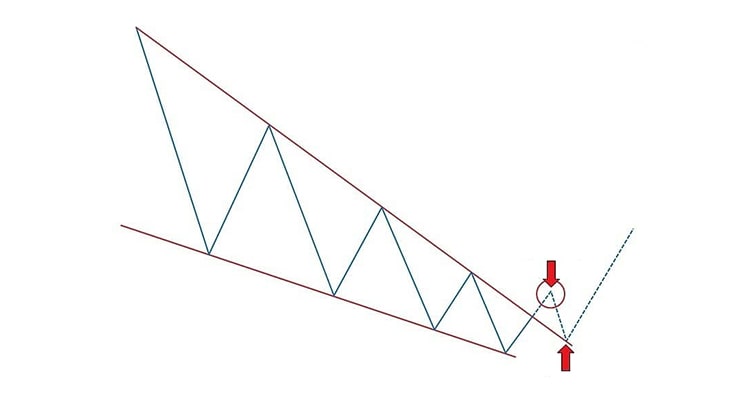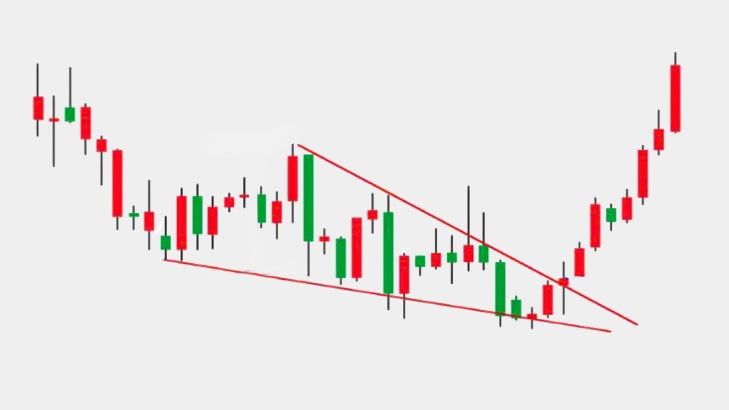
The falling wedge chart pattern is another common technical analysis pattern observed in financial markets. It’s the opposite of the rising wedge pattern and is characterized by converging trendlines that slope downwards. Here’s an overview:
Formation: A falling wedge pattern forms when the price of an asset consolidates between two descending trendlines. The upper trendline connects the lower highs, while the lower trendline connects the lower lows. Both trendlines slope downwards, with the lower trendline usually steeper than the upper one.
Bullish Reversal Pattern: Despite the term “falling,” this pattern is actually considered bullish. It suggests that while the price is making lower highs and lower lows, the downward momentum is weakening. This can be an indication of a potential reversal in the bearish trend.
Volume Analysis: Similar to the rising wedge pattern, volume analysis can help confirm the validity of the falling wedge pattern. Typically, volume tends to decline as the pattern progresses, signaling decreasing selling pressure.
Breakout: The confirmation of a falling wedge pattern occurs when the price breaks above the upper trendline. This breakout is often accompanied by increased volume, further validating the pattern. Traders often look for a decisive close above the upper trendline to confirm the bullish signal.
Price Target: The price target for a falling wedge pattern is usually measured by the height of the back of the wedge (the left side) and projected upwards from the point of breakout. This gives traders an estimate of how far the price might rise after the breakout.
False Breakouts: Just like with the rising wedge pattern, false breakouts can occur in falling wedges as well. Traders should wait for confirmation before taking action, as a brief move above the upper trendline followed by a return into the pattern could indicate a false breakout.
Pattern Failure: In some cases, the falling wedge pattern may not lead to a significant price increase. If the price breaks down below the lower trendline instead of above the upper one, it could signal a failed pattern. This could indicate a continuation of the previous trend or a period of further decline.
As always, it’s important to use the falling wedge pattern in conjunction with other technical analysis tools and indicators for confirmation and accuracy.

फॉलिंग वेज चार्ट पैटर्न वित्तीय बाजारों में देखा जाने वाला एक और सामान्य तकनीकी विश्लेषण पैटर्न है। यह उभरते हुए पच्चर पैटर्न के विपरीत है और नीचे की ओर ढलान वाली प्रवृत्ति रेखाओं को परिवर्तित करने की विशेषता है। यहाँ एक सिंहावलोकन है:
- गठन: एक गिरता हुआ पच्चर पैटर्न तब बनता है जब किसी परिसंपत्ति की कीमत दो घटती प्रवृत्ति रेखाओं के बीच समेकित होती है। ऊपरी ट्रेंडलाइन निचली ऊंचाई को जोड़ती है, जबकि निचली ट्रेंडलाइन निचली ऊंचाई को जोड़ती है। दोनों ट्रेंडलाइनें नीचे की ओर झुकती हैं, निचली ट्रेंडलाइन आमतौर पर ऊपरी ट्रेंडलाइन की तुलना में अधिक तीव्र होती है।
- बुलिश रिवर्सल पैटर्न: “गिरने” शब्द के बावजूद, इस पैटर्न को वास्तव में तेजी माना जाता है। इससे पता चलता है कि जब कीमत निम्न ऊंचाई और निचली ऊंचाई बना रही है, तो गिरावट की गति कमजोर हो रही है। यह मंदी की प्रवृत्ति में संभावित उलटफेर का संकेत हो सकता है।
- वॉल्यूम विश्लेषण: राइजिंग वेज पैटर्न के समान, वॉल्यूम विश्लेषण फॉलिंग वेज पैटर्न की वैधता की पुष्टि करने में मदद कर सकता है। आमतौर पर, जैसे-जैसे पैटर्न आगे बढ़ता है, वॉल्यूम में गिरावट आती है, जो बिक्री के दबाव में कमी का संकेत देता है।
- ब्रेकआउट: गिरते वेज पैटर्न की पुष्टि तब होती है जब कीमत ऊपरी ट्रेंडलाइन से ऊपर टूट जाती है। यह ब्रेकआउट अक्सर बढ़ी हुई मात्रा के साथ होता है, जो पैटर्न को और अधिक मान्य करता है। तेजी के संकेत की पुष्टि के लिए व्यापारी अक्सर ऊपरी ट्रेंडलाइन के ऊपर एक निर्णायक समापन की तलाश करते हैं।
- मूल्य लक्ष्य: गिरते वेज पैटर्न के लिए मूल्य लक्ष्य आमतौर पर वेज के पीछे (बाईं ओर) की ऊंचाई से मापा जाता है और ब्रेकआउट के बिंदु से ऊपर की ओर प्रक्षेपित किया जाता है। इससे व्यापारियों को अनुमान मिलता है कि ब्रेकआउट के बाद कीमत कितनी बढ़ सकती है।
- गलत ब्रेकआउट: बढ़ते वेज पैटर्न की तरह, गिरते वेजेज में भी गलत ब्रेकआउट हो सकते हैं। व्यापारियों को कार्रवाई करने से पहले पुष्टि की प्रतीक्षा करनी चाहिए, क्योंकि ऊपरी ट्रेंडलाइन के ऊपर एक संक्षिप्त कदम और उसके बाद पैटर्न में वापसी एक गलत ब्रेकआउट का संकेत दे सकती है।
- पैटर्न विफलता: कुछ मामलों में, गिरते वेज पैटर्न से महत्वपूर्ण मूल्य वृद्धि नहीं हो सकती है। यदि कीमत ऊपरी ट्रेंडलाइन के बजाय निचली ट्रेंडलाइन से नीचे गिरती है, तो यह एक विफल पैटर्न का संकेत दे सकता है। यह पिछली प्रवृत्ति के जारी रहने या आगे गिरावट की अवधि का संकेत दे सकता है।
हमेशा की तरह, पुष्टि और सटीकता के लिए अन्य तकनीकी विश्लेषण उपकरणों और संकेतकों के साथ फ़ॉलिंग वेज पैटर्न का उपयोग करना महत्वपूर्ण है।







